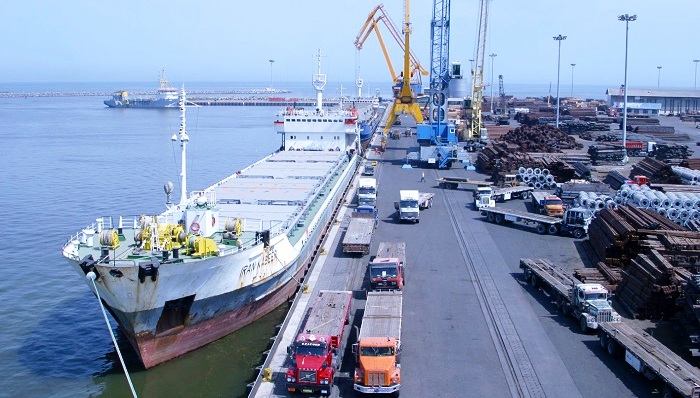The Chabahar port and its impacts on the regional transit trade
India started exporting wheat to Afghanistan through Iran last week, and on 29 Oct 2017 the Afghan and Indian Ministers of Foreign Affairs officially inaugurated trade through this port. This is the first time that India sends food stuff through Iran instead of Pakistan. Before this Pakistan had allowed India to do so only in case of emergencies.
India’s food aids are not as important as the transition of these aids through Chabahar port, which has evident importance from the trade, economy and a strategic point of view. For instance, according to the Indian Minister of External Affairs Sushma Suwaraj, it will develop trade in the region and will connect the region in areas of economy, politics, culture, technology, and services.
The phases of the Chabahar port agreement, the need for this port, and the impacts of the commenced trade through this port on the region are issues that are analyzed here.
The Chabahar port agreement
The Chabahar port is located in the South-east province of Iran, Balochistan. Based on its strategic geography, this port is located at the bank of Oman Gulf, close to the Hermez strategic strait, and is part of the Indian Ocean. This port has more than 14 thousand hectares of area and major chips can use it.
In 2003, when the BGP was in power in India, the agreement of this port was signed with the Iranian government. The Afghan government was also part of the agreement; however, due to international sanctions on Iran, the agreement to expand this port was delayed.
Despite the delay in the expansion of this port, India have spent about $135m to construct the Zaranj-Delaram Street, which connects Afghanistan’s Nimroz province to the Chabahar port. The construction of this street was completed in 2009. On the other hand, Iran has also invested $340m in the Chabahar trade zone.
Currently, this port has the capacity to load and unload 2.5 million tons annually and the Iranian government is trying to increase its capacity to 12.5 million tons every year. Moreover, Iran has started the construction of streets and railways between this port and the Afghan border, and the other countries in the region are also trying to invest in this port.
The recent trilateral agreement on this port was drafted by the Iranian-India-Afghan technical-economic groups and legal experts and was signed on 23 May 2016 in Iran by the leaders of the three countries.
The need for the Chabahar port
In the Chabahar port there are three groups of countries that have, somehow, rivalry or issues with Pakistan. One of the most important of these countries is Afghanistan that relied on Pakistan for its trade with the world since the past several decades. Pakistan has always used this reliance of Afghanistan as a political tool to pressurize this country and whenever the Kabul-Islamabad relations are deteriorated, it had adverse impacts on transit through Pakistan.
On the other hand, India and Pakistan have a traditional rivalry and enmity that is why Pakistan always try to keep Afghanistan and India apart because Pakistan want to avoid an Afghanistan-India coalition over the unsettled Durand-Line issue.
Although Iran’s rivalry with Pakistan is not to the extent of that of India and Afghanistan, due to economic profitability, Tehran wants Afghanistan’s trade with India and the world to be through Iran’s Chabahar port.
The failure of APTTAA agreement
APTTA is a transit-trade agreement between Pakistan and Afghanistan. After a longtime negotiations, Afghanistan and Pakistan signed the 2010 APTTA agreement to replace the 1965 ATA agreement. Based on this agreement, Pakistan allowed Afghanistan to use the Pakistani Qasem and Gwadar ports for transition purposes. Moreover, the Afghan traders were allowed to transport their goods until the Waga port in Lahore and get connected with India in areas of trade. Nevertheless, the Afghan traders were not allowed to import goods from India through the Waga port.
On the other hand, through Afghanistan, Pakistan found a way to trade with Central Asia and Iran. This agreement continued until 2015, and then Afghanistan demanded full allowance for trade with India if the agreement was to be extended.
However, since 2010, the Afghan government have made efforts to increase its transit ways (the Afghan government held some steps to construct the Lapis Lazuli and Chabahar ports) so that it could prevent Pakistan from using the transit way as a tool of political pressure. After the formation of the National Unity Government, these efforts increased and Afghanistan, India, and Iran signed the agreement of Chabahar port in order to bypass Pakistan.
The Chabahar port and its impact on regional politics
Trade between Iran, India, and Afghanistan through Chabahar port could have impacts in the following aspects:
First, Iran’s Chabahar port will substitute Pakistan’s Karachi, Qasem and Guader ports in the Afghan trade.
Second, trade through Chabahar port can also give a means of pressure at the hand of Afghanistan to pressurize Pakistan saying that if Pakistan wants to have trade with the Central Asia through Afghanistan, it has to allow Afghanistan to trade with India through Pakistan.
Third, since the Lapis Lazuli road is not opened yet, the closest way of trade with Europe for Afghanistan is also the Chabahar port.
Fourth, through the Chabahar port, India can expand its role in the Central Asia, something that India could never do through the transit ports in Pakistan.
Fifth, the Chabahar port deal will also increase the regional economic solidarity and trade, something that has been affected by the negative trade policies of Pakistan (negative security policy).
Sixth, the transition of the recent cargo of aids through this port will also decrease the criticisms on this port. This will decrease the obstacles on the way of trade through the Chabahar port.
The End

